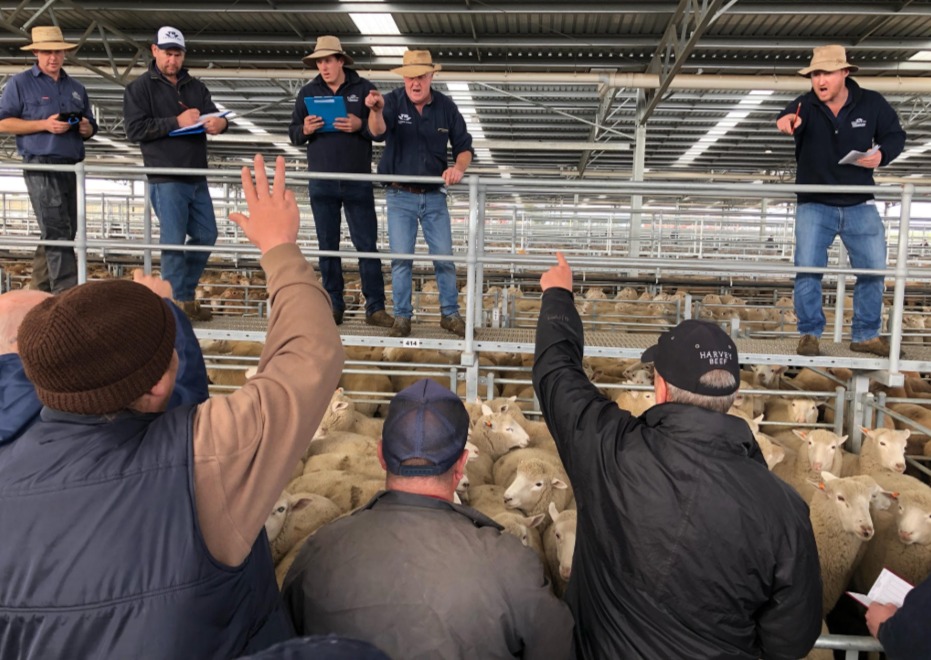 SALEYARD trade, export and restocker lamb prices slipped across the eastern states in the past week as seasonal conditions and water concerns increased sales of lighter lambs in the north and the southern sucker turn-off gained momentum.
SALEYARD trade, export and restocker lamb prices slipped across the eastern states in the past week as seasonal conditions and water concerns increased sales of lighter lambs in the north and the southern sucker turn-off gained momentum.
Trade and export lamb rates firmed slightly later in the week, with processors paying more for quality southern trade and heavy lambs in some centres, while restockers picked through the large drafts of drier seasonally-affected light lambs coming into New South Wales centres.
Tim Francis from H. Francis and Co at the Wagga Wagga saleyards said the market is getting swamped by light lambs, with Merino lambs making down to $30-$40.
He expected the light lamb turn-off to continue from out west and the Monaro, with warmer weather yet to come. Stock water is becoming an increasing problem with many predicting they would not get through the summer months with existing supplies, he said.
Southern lamb restockers were being selective, Mr Francis said, buying the better drafts with weight able to be shorn and brought back in for sale in March and April.
“I think you will see a lot of good lambs at the end of January into February.”
Mr Francis said heavy sheep processors could not get enough supply.
“I think the lamb numbers will cut out at about mid-January and then you will see them peak again.
“A lot of fellows have been selling sheep in good order and they are getting paid for them, but we are running out of them and I think sheep numbers will come back mid-January.”
Price gap between mutton and trade lamb is shrinking
The Eastern Trade Lamb Indicator closed 694c/kg on Thursday, 33 cents lower than a week ago and 65 cents below last month. The ES heavy lamb indicator finished at 704 on Thursday, 24 cents lower than last week and 50 cents below its level a month ago.
The ES restocker indicator dropped 7 cents to 747c/kg on Thursday, 33 cents lower than last week, and 61 cents below its mark a month ago.
Mutton prices; however, have been less affected, with numbers starting to drop in some areas and ES indicator closing at 581 cents on Thursday, 13 cents lower than last week, but equal to its level one month ago.
The strength of mutton demand, especially into China, has meant the price difference between lamb and mutton this week reached its lowest point in the eastern states since 2011.
Meat & Livestock Australia market analyst Toby Pitt confirmed that the premium of the ES trade lamb indicator to mutton is now 16 percent and got as low as 25pc for the national indicators. Yesterday, the national trade lamb indicator was 18pc above the mutton indicator.
He said the closest the ES mutton indicator got to the ESTLI was 49 cents in July 2011, when there was a 10pc premium between the indicators – lamb at 485c/kg vs mutton at 436c/kg. The ES trade lamb indicator at 693c/kg on Wednesday was at its lowest point since early April this year.
Mr Pitt said the decline in the national flock is likely to cause a tightening of mutton and lamb supply through the winter months of 2020, similar to the pattern seen through 2018 and 2019, as there is less breeding ewes available for lamb production.
“The timing of the decline is likely to be similar or slightly earlier than 2019 as lambs processed in the back half of 2019 tracks relatively high, suggesting there will be fewer remaining available by autumn 2020.
“However, the strong prices for heavy lambs may encourage some producers to hold lambs back longer than normal in order to reach heavier weights.”
Mr Pitt said the lower premium of trade lamb over mutton prices is particularly impressive considering the current strength of the lamb market in a historical sense.
“While mutton prices have eased slightly from July when the indicator surpassed 600c/kg cwt, they have generally remained elevated above 550c/kg, a price which in itself would have been almost incomprehensible before 2019.
“With mutton’s stability, it is the waning trade lamb prices that is the biggest factor in prices for sheep young and old becoming more aligned.
“The National Trade Lamb Indicator decreased to 706c/kg cwt on Tuesday, the lowest point since April,” he said.
“The strengthening of the mutton market, while not always being obvious, is a trend that has been occurring for over 12 months.”
Mr Pitt said the main driver for the mutton market is the strength of international demand.
“China in particular is going from strength-to-strength as a trading partner, the destination for 42pc of 2019 mutton exports, while Malaysia and the US are also playing a significant role.”

HAVE YOUR SAY